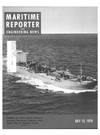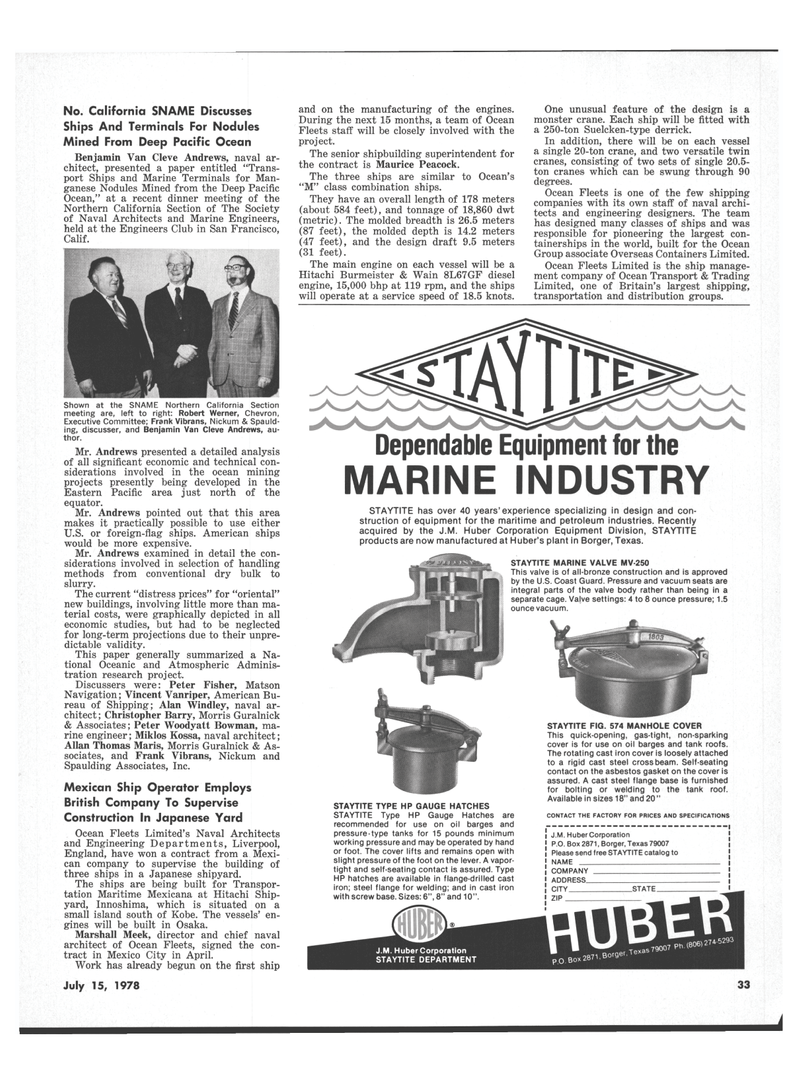
Page 31: of Maritime Reporter Magazine (July 15, 1978)
Read this page in Pdf, Flash or Html5 edition of July 15, 1978 Maritime Reporter Magazine
No. California SNAME Discusses
Ships And Terminals For Nodules
Mined From Deep Pacific Ocean
Benjamin Van Cleve Andrews, naval ar- chitect, presented a paper entitled "Trans- port Ships and Marine Terminals for Man- ganese Nodules Mined from the Deep Pacific
Ocean," at a recent dinner meeting of the
Northern California Section of The Society of Naval Architects and Marine Engineers, held at the Engineers Club in San Francisco,
Calif.
Shown at the SNAME Northern California Section meeting are, left to right: Robert Werner, Chevron,
Executive Committee; Frank Vibrans, Nickum & Spauld- ing, discusser, and Benjamin Van Cleve Andrews, au- thor.
Mr. Andrews presented a detailed analysis of all significant economic and technical con- siderations involved in the ocean mining projects presently being developed in the
Eastern Pacific area just north of the equator.
Mr. Andrews pointed out that this area makes it practically possible to use either
U.S. or foreign-flag ships. American ships would be more expensive.
Mr. Andrews examined in detail the con- siderations involved in selection of handling methods from conventional dry bulk to slurry.
The current "distress prices" for "oriental" new buildings, involving little more than ma- terial costs, were graphically depicted in all economic studies, but had to be neglected for long-term projections due to their unpre- dictable validity.
This paper generally summarized a Na- tional Oceanic and Atmospheric Adminis- tration research project.
Discussers were: Peter Fisher, Matson
Navigation; Vincent Vanriper, American Bu- reau of Shipping; Alan Windley, naval ar- chitect ; Christopher Barry, Morris Guralnick & Associates ; Peter Woodyatt Bowman, ma- rine engineer; Miklos Kossa, naval architect;
Allan Thomas Maris, Morris Guralnick & As- sociates, and Frank Vibrans, Nickum and
Spaulding Associates, Inc.
Mexican Ship Operator Employs
British Company To Supervise
Construction In Japanese Yard
Ocean Fleets Limited's Naval Architects and Engineering Departments, Liverpool,
England, have won a contract from a Mexi- can company to supervise the building of three ships in a Japanese shipyard.
The ships are being built for Transpor- tation Maritime Mexicana at Hitachi Ship- yard, Innoshima, which is situated on a small island south of Kobe. The vessels' en- gines will be built in Osaka.
Marshall Meek, director and chief naval architect of Ocean Fleets, signed the con- tract in Mexico City in April.
Work has already begun on the first ship and on the manufacturing of the engines.
During the next 15 months, a team of Ocean
Fleets staff will be closely involved with the project.
The senior shipbuilding superintendent for the contract is Maurice Peacock.
The three ships are similar to Ocean's "M" class combination ships.
They have an overall length of 178 meters (about 584 feet), and tonnage of 18,860 dwt (metric). The molded breadth is 26.5 meters (87 feet), the molded depth is 14.2 meters (47 feet), and the design draft 9.5 meters (31 feet).
The main engine on each vessel will be a
Hitachi Burmeister & Wain 8L67GF diesel engine, 15,000 bhp at 119 rpm, and the ships will operate at a service speed of 18.5 knots.
One unusual feature of the design is a monster crane. Each ship will be fitted with a 250-ton Suelcken-type derrick.
In addition, there will be on each vessel a single 20-ton crane, and two versatile twin cranes, consisting of two sets of single 20.5- ton cranes which can be swung through 90 degrees.
Ocean Fleets is one of the few shipping companies with its own staff of naval archi- tects and engineering designers. The team has designed many classes of ships and was responsible for pioneering the largest con- tainerships in the world, built for the Ocean
Group associate Overseas Containers Limited.
Ocean Fleets Limited is the ship manage- ment company of Ocean Transport & Trading
Limited, one of Britain's largest shipping, transportation and distribution groups.
Dependable Equipment for the
MARINE INDUSTRY
STAYTITE has over 40 years'experience specializing in design and con- struction of equipment for the maritime and petroleum industries. Recently acquired by the J.M. Huber Corporation Equipment Division, STAYTITE products are now manufactured at Huber's plant in Borger, Texas.
STAYTITE MARINE VALVE MV-250
This valve is of all-bronze construction and is approved by the U.S. Coast Guard. Pressure and vacuum seats are integral parts of the valve body rather than being in a separate cage. Valve settings: 4 to 8 ounce pressure; 1.5 ounce vacuum.
STAYTITE TYPE HP GAUGE HATCHES
STAYTITE Type HP Gauge Hatches are recommended for use on oil barges and pressure-type tanks for 15 pounds minimum working pressure and may be operated by hand or foot. The cover lifts and remains open with slight pressure of the foot on the lever. A vapor- tight and self-seating contact is assured. Type
HP hatches are available in flange-drilled cast iron; steel flange for welding; and in cast iron with screw base. Sizes: 6", 8" and 10".
STAYTITE FIG. 574 MANHOLE COVER
This quick-opening, gas-tight, non-sparking cover is for use on oil barges and tank roofs.
The rotating cast iron cover is loosely attached to a rigid cast steel crossbeam. Self-seating contact on the asbestos gasket on the cover is assured. A cast steel flange base is furnished for bolting or welding to the tank roof.
Available in sizes 18" and 20"
CONTACT THE FACTORY FOR PRICES AND SPECIFICATIONS
J.M. Huber Corporation
P.O. Box 2871, Borger, Texas 79007
Please send free STAYTITE catalog to
NAME
COMPANY
ADDRESS
CITY. .STATE_
July 15, 1978 33

 30
30

 32
32
